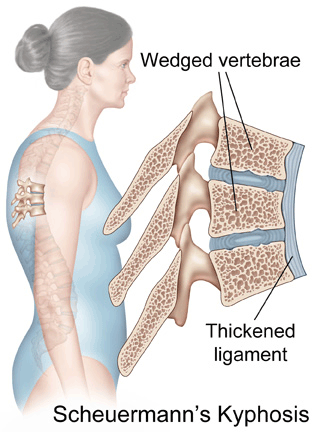Adult Kyphosis - Types and Causes
Postural Kyphosis
Postural kyphosis-sometimes called "round back"-is the result of poor posture. This condition is most common in adolescents and young adults. Slouching when standing or sitting causes the spine to curve forward. Postural kyphosis is often accompanied by hyperlordosis of the lumbar (lower) spine. The lumbar spine naturally has a lordosis or inward curve. Hyperlordosis means the lumbar spine compensates for too much thoracic kyphosis by curving too far in the inward direction.
A postural kyphosis corrects itself when lying down on a flat surface, or when the spine is hyper-extended. There are no noticeable vertebral abnormalities on X-rays because structural damage or deformity does not cause this kyphosis. Postural kyphosis is easily corrected with education about proper posture, including some retraining on how to sit and stand correctly. Special bracing or casting is usually not necessary. Strengthening exercises for the back muscles can be helpful in correcting posture.
Scheuermann's Kyphosis
Scheuermann's kyphosis affects the shape of the vertebral bodies in the mid back. The front of several vertebral bodies becomes narrow. The affected bones appear wedge-shaped, producing forward rounding (kyphosis) in the thoracic spine.
Researchers are unsure what causes Scheuermann's kyphosis. Genetics appear to have a role, meaning it runs in families. Spine specialists suspect the problem may have to do with damage in the area where growth occurs in the vertebral body. Others suggest mild osteoporosis or muscle abnormalities could contribute to the deformity.
Learn more about Scheuermann's Kyphosis.
Congenital Kyphosis
Congenital kyphosis means a person is born with some sort of defect, such as incomplete formation of the spine. This can lead to a severe abnormal kyphosis. Extreme kyphosis is the most common cause of paralysis in the lower part of the body, other than trauma or infection. With congenital kyphosis, there is a strong (20-30 percent) association of congenital abnormalities with the body's urinary collecting system. If this type of kyphosis is suspected, your doctor may suggest that you have a special X-ray that looks at the kidneys (called an IVP), an ultrasound of the kidneys, a myelogram, or an MRI. The myelogram and the MRI can show whether or not the parts of the spine have developed normally. A 3-D CT scan gives a three dimensional view of the misshapen vertebrae.
Severe congenital kyphosis deformities are usually treated surgically. Conservative treatment plans are less successful at correcting this type of kyphosis. Early surgical intervention generally produces the best results and can prevent progression of the curve. The type of surgical procedure will depend on the nature of the abnormality.
If nonsurgical treatment is chosen, there is a critical need for observation and close medical follow-up to prevent possible problems later.

Paralytic Disorders
Conditions that cause paralysis can lead to kyphosis. Paralysis can be caused by disorders such as Polio, muscular dystrophy, and Cerebral Palsy (paralysis caused by trauma at birth or developmental defects in the brain). The development of kyphosis in these cases is gradual rather than sudden.
Post-Traumatic Kyphosis
Injury to the spine can lead to progressive kyphosis and nerve problems in the spine. A vertebral fracture in the thoracic or lumbar spine will almost always cause some degree of kyphosis. Post-traumatic kyphosis is sometimes treated with either bracing or surgery. The choice will depend on the severity of the condition.
Post-Surgical Kyphosis
Kyphosis can develop after spine surgery has been done to correct other problems. This usually occurs when the procedure does not heal as intended. For example, a spine fusion may not heal, and the unstable fusion may cause the spine to collapse into kyphosis. The ligaments of the spine may not heal strongly enough to support the vertebrae, and a kyphosis develops. A second operation might be needed.
Degenerative Kyphosis
There are cases of kyphosis that are caused by degeneration (wear and tear of the spine). Over time, the degenerative process can result in collapse of the intervertebral disc, changes in the shape of the vertebrae, and weakening of the ligaments that support the spine. This can result in the gradual development of a kyphosis over many years. Once the kyphosis begins to form, it gets worse because the imbalance of the forces continually increases the wear and tear.
Other Causes
Different types of systemic (whole body) diseases can cause a kyphosis to develop over time. These conditions include infection in the spine, cancer or tumors that involve the spine, and different types of systemic arthritis. These conditions affect the bones and soft tissues of the mid back and may produce kyphosis. Children with cancer sometimes need radiation treatment. Radiation of the spine in childhood can alter the strength of the spinal vertebrae, leading to kyphosis later in life.
